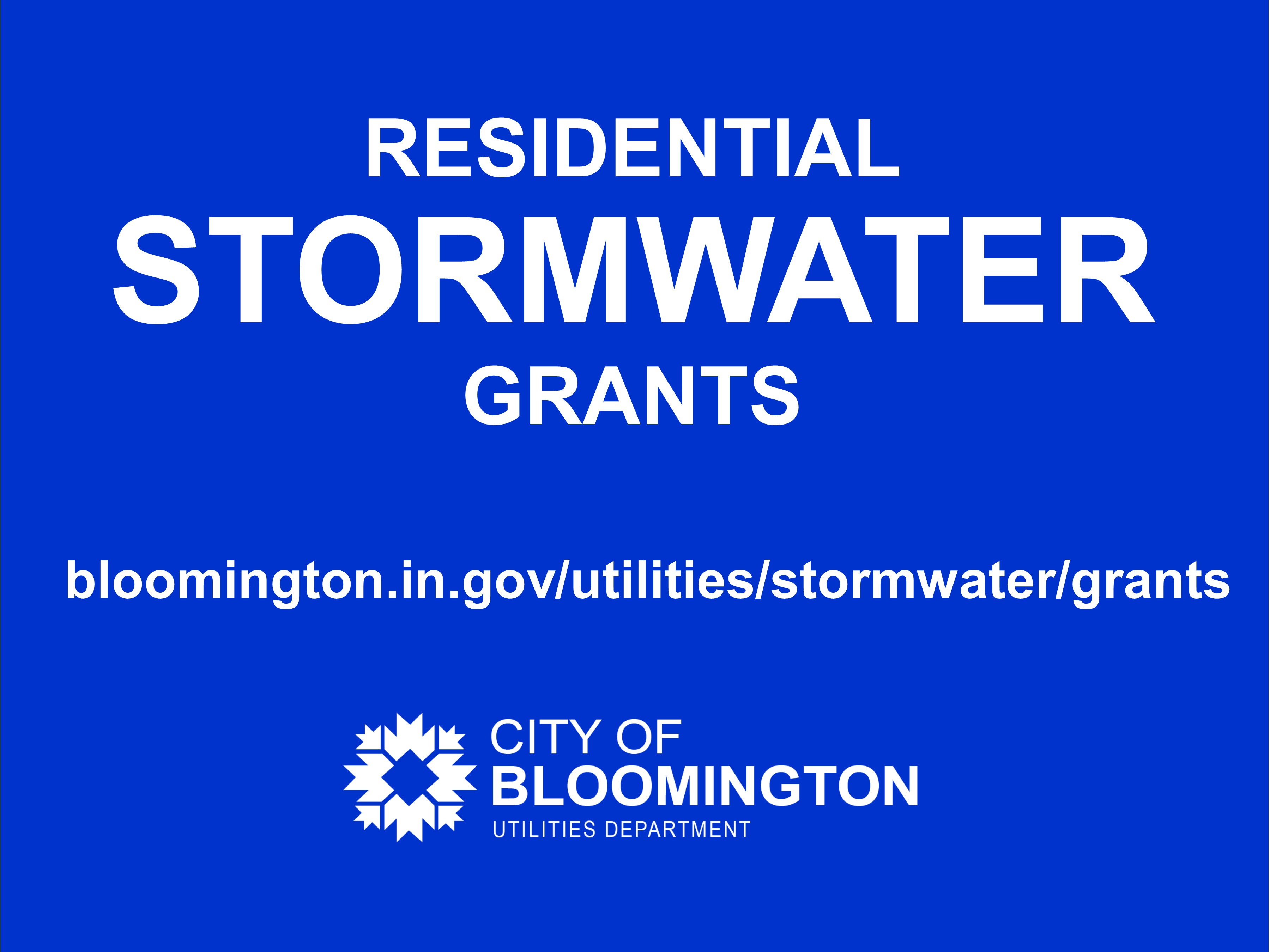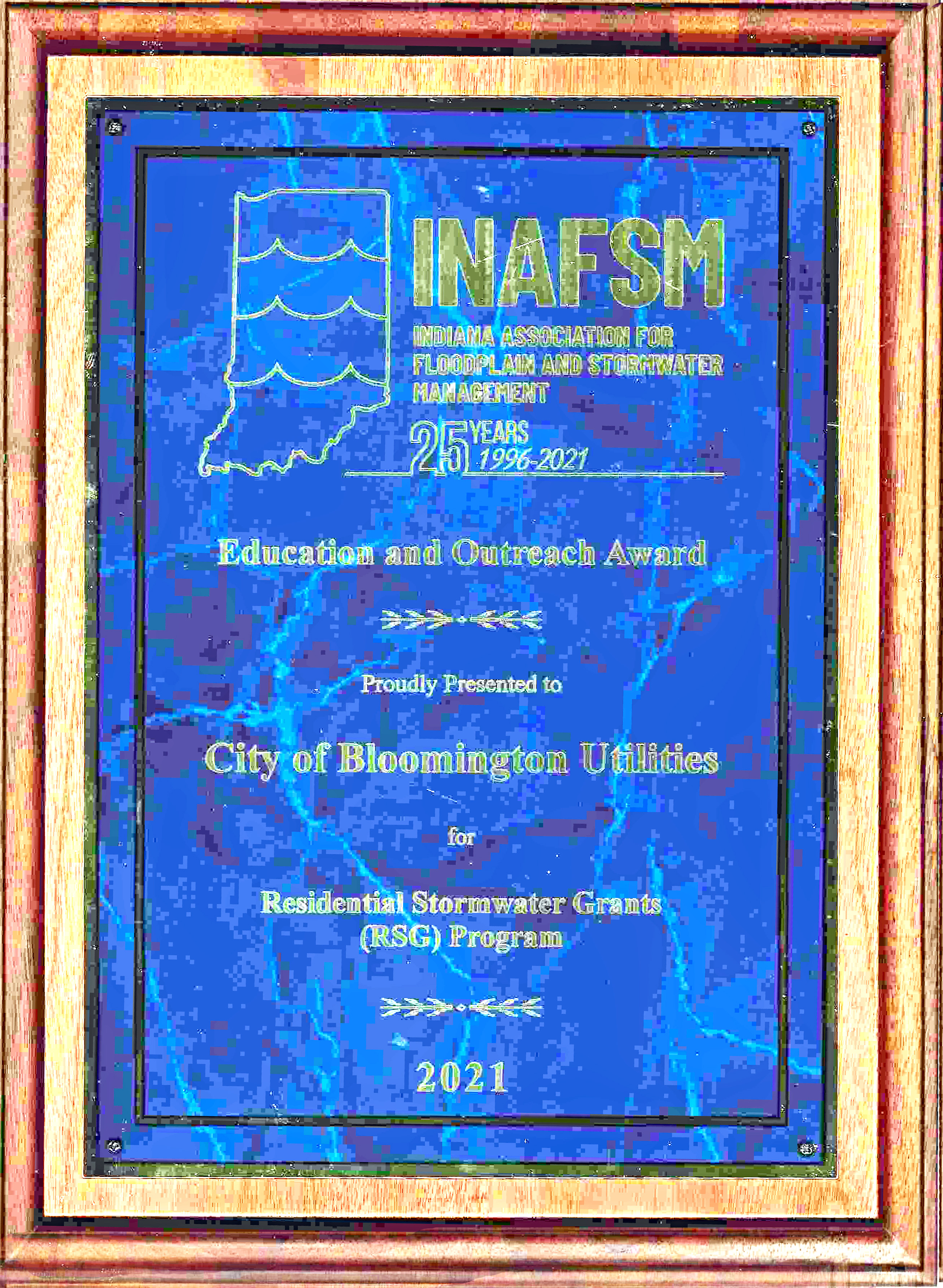Page last updated on September 5, 2025 at 1:20 pm

Many property challenges start with stormwater quality and quantity issues; below are a few opportunities that can help.
In this section, you will find information on:
- Residential Stormwater Grants (stay tuned for program updates)
- Site Visits and Resources
- Stormwater Resources/Education Series
______________________________________________________________________


1. RESIDENTIAL STORMWATER GRANTS 2024
The deadline for Residential Stormwater Grant 2024 is September 1, 2024, 5 p.m. We encourage you to start educating yourself on the resources and practices available in the FAQs, presentations, links, videos and more, below. As the process of updating the program and materials evolves, the 2023 information can be referenced as a guideline. Feel free to contact us with any questions you may have.
Qualifications
- Single-family, owner-occupied homes on private residential property.
- Those who pay the City of Bloomington's stormwater fee (to check, see your water bill).
Related information
Residential Stormwater Grants 2024 Press Release Page 1
Residential Stormwater Grants 2024 Press Release Page 2
Residential Stormwater Grants 2024 Flyer
Residential Stormwater Grants Brochure
Residential Stormwater Grants 2024 FAQs General
Please follow the procedures listed, below.
1) Homeowner Driven - The Residential Stormwater Grants program is homeowner driven. We suggest that you become familiar with the information in "3. Stormwater Resources/Education Series," below; it will be helpful for you in making decisions regarding your stormwater challenge in collaboration with your contractor.
Note: As stormwater tends to be connected on large scales, make sure you collaborate with your neighbors (it's also just a neighborly thing to do!). You can submit on the same Application if your properties are contiguous. Please designate one point of contact and include all names/addresses in your Application. Projects containing "greener" stormwater solutions and residing in lower income areas tend to be viewed more favorably.
2) Public Information Meeting (optional and recommended) (Thursday, April 18, 2024, 5:30 - 7 p.m.)
A Public Information Meeting will be held on Thursday, April 18, 2024, 5:30 - 7 p.m., City of Bloomington Utilities Service Center, 600 E. Miller Drive, Bloomington, Indiana 47401. Parking (free) is available on the north and west sides of the building. In the meantime, the Powerpoint presentation and recorded meeting links from 2023 are, below:
- Click here to see the 2024 Powerpoint presentation
- Click here to watch the 2024 Community Access Television Services (CATS) recording of the meeting
3) Guidelines (TBA) - Read the Guidelines; they will help you with everything from next steps to project ideas and maintenance suggestions. As mentioned previously, the "Resources" and "3. Homeowner Education Series" sections, below, also provide helpful information on understanding stormwater and practices that can help with drainage such as rain gardens, bioswales, dry creek beds, native plants, and more.
Here is a sample Grant Agreement (TBA); you (and your neighbors, if applicable) will be expected to sign a similar document if you are awarded a grant.
4) Contractor - Find a contractor (we suggest getting at least three opinions but choosing only one and one solution). You are welcome to use any contractor you wish. Note: Do-It-Yourself (DIY) projects are also allowed.
Residential Stormwater Grants 2024 FAQs For Contractors
Make sure you obtain an Estimate, at least as close as possible, as it will be needed to complete your Application, see below; in addition, make sure the document does not include tax (CBU is tax exempt).
Be mindful of regulations in relation to property lines, permits, easements, rights-of-way, alleys, conservancies, and so on as you and your Contractor are responsible for taking them into account (you may need to have a professional survey done; if so, the grant, if awarded, will cover the costs).
Below is a list of suggested questions to ask a contractor while making your selection:
- Do they work on small projects (most tend to be between about $2,000 and $7,000, depending on the situation and proposed solution)?
- Are they licensed, bonded and insured?
- Do they have drainage experience and, if so, what is it?
- Are they familiar with native plants and invasive plants?*
- Will they provide you with plans (a sketch), including maps, as well as an itemization? Be mindful of materials (for example, biodegradeable erosion control netting is preferred over that which is not),
- Will they give you examples of projects they have completed?
- Will they offer you their references?
- Will they warranty their work?
* Information to keep in mind regarding plants for your project...
The Bloomington Municipal Code lists these permitted and prohibited plants.
Regarding information on local invasive and native plants, Monroe County Identify and Reduce Invasive Species (MC-IRIS) has a great deal of resources, including resources for landowners .
Another source for Indiana native/invasive plant information can be found on the Indiana Native Plant Society website, including photos.
In addition, as of April 18, 2020, the Indiana Terrestrial Plant Rule (312 IAC 18-3-25) went into effect. There are 44 plants on the regulated list. They tend to be invasive and some actually harm water quality. For example, bush honeysuckles even exude chemicals that keep other plants from growing nearby, hence encouraging runoff and soil loss. Therefore, it is now illegal to sell, gift, barter, exchange, distribute, transport, or introduce them without a permit. Native plants are a better choice as they are adapted to local climates, support pollinators, and generally have longer roots to hold soil in place.
5) Application - Submit an Application. Fill it out given your current drainage situation. Please be as clear and concise as possible and choose only one solution (do not submit multiple options). The link will also ask for additional information including the following:
- A clear and concise definition of your preferred project (remember, choose just one).
- Project sketch (even if just "by hand"). Be sure to include the direction North at the top, features, direction of flow, and anything else helpful to visualize your concept. Note: Please coordinate the definition of your preferred project with the sketch, you may even wish to number the items.
- Estimate from contractor, including an itemization (even if just a "ballpark" figure).
- Photos in JPG format (a long shot and those that show a bit more detail, as necessary).
- Any other information that would be helpful.
6) After submitting - You will receive a confirmation that your Application was received and we will be in touch with you as soon as possible with an update on the process. All Applications will be reviewed by a Review Committee. Projects containing "greener" stormwater solutions, improving larger/contiguous residential properties as well as private connections to the City's stormwater system and stormwater system as a whole, and residing in lower income areas tend to be viewed more favorably.
______________________________________________________________________
AWARDS
The Residential Stormwater Grants (RSG) program has received the following awards:
- Outstanding Indiana MS4 Special Project from the Indiana MS4 Partnership during the Spring 2023 Annual Conference.

- Education and Outreach award from the Indiana Association for Floodplain and Stormwater Management during the Fall 2021 Annual Conference.
______________________________________________________________________
TESTIMONIALS
- 1700 S. Clifton Ave. Project
Through its Residential Stormwater Grant program, the City of Bloomington works with homeowners to improve drainage and erosion issues on their property in green and sustainable ways. In this example, the homeowner had an issue with stormwater flooding and stagnating in their backyard. Thanks to a grant and planning assistance from the city, a contractor was able to design and build a system to channel the stormwater through a bed of water-loving native plants to absorb and clean the water before discharging it to the city stormwater system.
The homeowner first read about the Residential Stormwater Grant program in the local newspaper. After submitting an application and proposal, CBU Environmental staff replied with several ideas on ways to incorporate green design and native species. The contractor revised the design to build “up” with a berm instead of digging down to form a dry creek bed, and several trees were saved by preserving their root structure.
From first proposal to planting of native plants in the spring, the entire process took about one year, including the revision process.
“The CBU staff were really helpful,” said the homeowner in a follow-up interview. “I’m just really pleased with how it turned out."
Thank you and take good care!

A dry creek bed in progress (native plants have been added since the photo was taken)
Credit: Residential Stormwater Grants 2020, CBU Staff
___________________________________________________________________________________________
2. NEIGHBORHOOD VISITS AND RESOURCES
Presentations for and visits to neighborhoods
The City of Bloomington Utilities offers a number of ways to work with stormwater. We are in the process of bringing back and updating our neighborhood visits program for the first time since the pandemic began. The effort will include presentations for and visits to neighborhoods. In the meantime, grants are available (see, "1. Residential Stormwater Grants" (above). Please watch this site for more information, it will be updated as the initiative evolves.
The intent is to improve the quality and quantity of stormwater while sustainably managing drainage and erosion concerns.
![]()
Credit: Tenth Acre Farm
Example projects include those for green infrastructure, such as rain gardens, vegetated buffer strips and swales, culvert replacements, and more.
Please contact us at [email protected] if you would like more information.
Interested in neighborhood improvement, in general? Check out the City of Bloomington Housing and Neighborhood Development website.
___________________________________________________________________________________________
3. STORMWATER RESOURCES/EDUCATION SERIES
We hear you! An educational series, bringing together expertise from various departments and community organizations, is in the works for residents, homeowners, neighborhood associations, and homeowner associations based upon observations derived by stormwater concerns expressed through the Residential Stormwater Grants program and more. The program includes expertise from related City departments and community organizations in a "one-stop-shopping" format. Our intent is to provide proactive, positive and productive education on stormwater to limit its negative impacts on land and the built environment (of particular importance as our climate changes) to help with quality of life aspects.
The evolving series consists of resources, short videos, presentations, and more.
Resources
Stormwater Fun Fact (thanks to local researchers): Cicada holes and (storm)water infiltration.
- Local! And, a good overview to start with... City of Bloomington Utilities - Water Works, Sewer Works, and Stormwater Video (10:29)
- Local! Press Release - Press Release regarding stormwater information for neighborhoods
- Local! City of Bloomington Plants Fact Sheet - Which plants should I use and not use? - Plants to consider
- Local! Switchyard Park Field Guide - Green infrastructure and native plants in action
- Local! NEW! Switchyard Park Landscaping Plant Field Guide
- Local! Monroe County Stormwater's Rain Garden Page - Rain garden information
- Local! Monroe County Rain Garden Starter Guide - Great ideas for starting a rain garden!
- Local! Monroe County Identify and Reduce Invasive Species - Including FREE native plants for reducing invasive species, http://mc-iris.org/reduce-one-invasive-species-challenge.html)
- Local! Monroe County Identify and Reduce Invasive Species - 2022 target species: Callery Pear
- Local! Southern Indiana Cooperative Invasives Management - Invasive plant management in southern Indiana
- Local! Indiana University - Environmental Resilience Institute - Preparing for our changing climate and more
- Local! Purdue University - Climate Change Research Center - Preparing for our changing climate and more
- Local! IDNR District Forester - see, "District 18 - Monroe, Owen counties"
- Local! The City of Bloomington's Grants webpage - For the Residential Stormwater Grants program and beyond
- Local! Indianapolis area and beyond. White River Alliance, Stormwater Landscape Maintenance Training for HOAs.
- Local! City of Bloomington Stormwater Related Ordinances can be found here
- Local! City of Bloomington Stormwater Fee rate Information can be found here
- Local! Community Justice and Mediation Center
- Local! Press Release (November 17, 2022): Fall and Winter Tips: Options for Leaves, and Keeping Sidewalks and Storm Drains Clear
- Local! Monroe County Organizations Active in Disaster - Tips on preparing your home for heavy rainfall, how to get involved and more
- Climate Psychology Alliance of North America
- Shades of Green Permaculture - Working permaculture concepts into your design
- Rainscaping - Missouri Botanical Gardens - A great resource for landscaping while keeping rain in mind
- Rain Garden Alliance
- Grass Swales - Virginia Cooperative Extension
- Vegetated Swales - Dauphin County Conservation District
- Swale Fact Sheet - Sussex Conservation District
- Grass Drainage Swale - Hartford County Government
- Homeowners Guide to Stormwater - An overview of stormwater management for homeowners (although written for a different area, it contains good information that can be inferred for Bloomington)
- Watch this video from the Indiana Association for Floodplain and Stormwater Management - Pond Maintenance Tips
- Watch this video, "What can I do with all these leaves?!?", read this brochure, and visit the city's "leafing" home page - What to do with all those leaves?
- Stormwater Ponds: Inspection and Maintenance Considerations - Clemson Cooperative Extension Home & Garden Information Center
- Pools and Other Water Features Brochure - Information on how to drain pools and other water features
- Pools and Other Water Features Poster - Information on how to drain pools and other water features
- Stormwater Utility Credit Manual
A note about plants: Something to keep in mind regarding plants for your project... As of April 18, 2020, the Indiana Terrestrial Plant Rule(312 IAC 18-3-25) went into effect. There are 44 plants on the regulated list. They tend to be invasive and some actually harm water quality. For example, bush honeysuckles even exude chemicals that keep other plants from growing nearby, hence encouraging runoff and soil loss. Therefore, it is now illegal to sell, gift, barter, exchange, distribute, transport, or introduce them without a permit. Native plants are a better choice as they are adapted to local climates, support pollinators, and generally have longer roots to hold soil in place.
Topics include:
- A definition of stormwater in context to Bloomington and the surrounding area
- Our changing climate and its impact on stormwater (and your property)
- Adapting to the challenges
- Local soils in relation to the built environment
- Landscaping techniques to prevent erosion and preserve soil (and benefit structures)
- Stormwater practices that help with drainage concerns
- Connecting parcels and working at a watershed level
- Maintenance of stormwater features, including rain gardens, swales, dry creek beds, ponds, etc.
- Public/private and green/gray infrastructure interfaces
- Working together for mutual benefit
- Available grants and other City-related endeavors that coordinate nicely with the Residential Stormwater Grants program
- Good examples
- Other steps communities can take to help with stormwater quality and quantity concerns
- Possibilities
- Resources
- More!
Background education titles include (slideshow):
"One-Minute" Stormwater Education Video Series:
- See the City of Bloomington's growing YouTube Stormwater Playlist, "CBU STORMWATER VIDEOS", here.
- "How to fill out a stormwater-related uReport (0m:47s)
- "We all live in a watershed" (01m:00s)
- "National Water Quality Month" (August) (01m:33s)
- "Where does our water go?" (01m:08s)
- "Best Practices: Lawn Mowing" (01m:06s)
- "Best Practices: Working with Plants" (01m:22s)

---
Back to the Stormwater home page
To report a stormwater concern, use the uReport website (Video: How to fill out a stormwater-related uReport - 0m:47s)
For more information on stormwater, in general, please visit our Stormwater Education page
For information on adopting a storm drain, please visit our Adopt-a-Drain page

